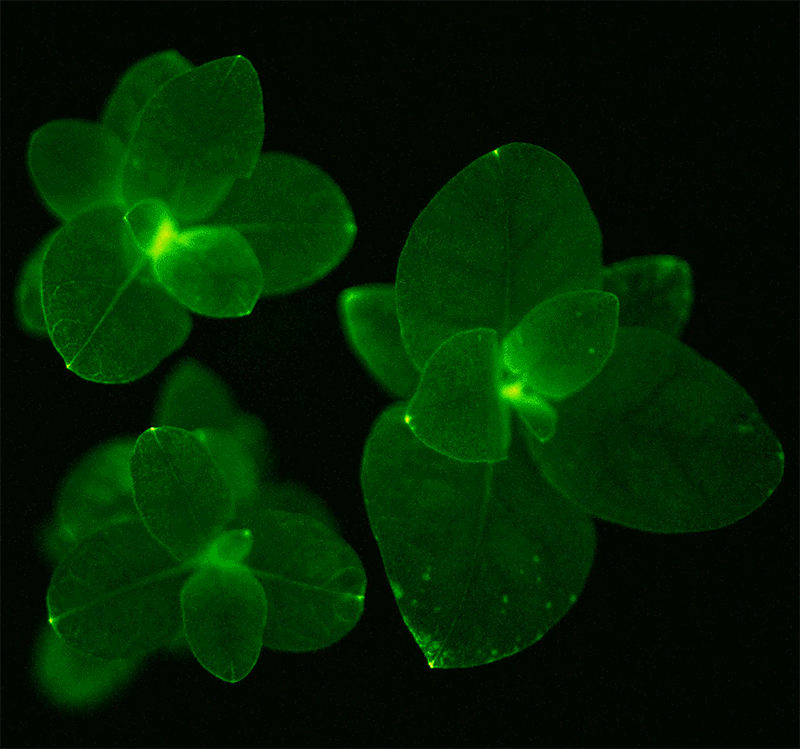Hello Nature readers, would you like to get this Briefing in your inbox free every day? Sign up here.

Fast-growing parts of the plant, such as budding flowers and leaves, glow the brightest.Credit: Light Bio
Plant lovers in the United States will soon be able to buy glowing petunias (Petunia hybrida). The US$29 plant, sold by biotech firm Light Bio, contains genes from a bioluminescent mushroom (Neonothopanus nambi). Because this type of petunia is not native to North America and is not considered an invasive species, the chances of the modified genes spreading should be minimal. This is a “groundbreaking event”, says plant biologist Diego Orzáez. He suggests that having “something people can touch and bring home” could even help people to be less scared of genetic engineering.
Nature | 6 min read
High-profile climate scientist Michael Mann was awarded more than US$1 million in a lawsuit against two conservative blog authors. In 2012, they challenged Mann’s research and drew parallels to a convicted child molester. The verdict could serve as a warning for those who attack researchers in controversial fields, including climate science and public health. Mann hopes the win “signals the beginning of the end of the open season on scientists by ideologically-motivated bad actors”.
Nature | 6 min read
Air pollution makes the scent of a night-blooming plant less enticing to pollinating moths. Researchers discovered that nitrate radicals severely degrade key odour components that attract pollinating insects to the pale evening primrose (Oenothera pallida). Nitrate radicals, which can come from various sources including vehicle emissions, are particularly abundant when there’s no sunlight to break them down. Artificial flowers spiked with the pollution-degraded scent received 70% fewer visits from wild hawkmoths than fake flowers with intact odour. Because hawkmoths are some of the primrose’s main pollinators this could reduce the plant’s fruit production by almost 30%.
The New York Times | 4 min read
Reference: Science paper
Features & opinion
Many researchers published their first preprint during the COVID-19 pandemic — and most of them would do it again, a survey of some 670 authors revealed. Part of the positive experience was receiving comments from peers, with more than 20% saying they made substantial changes because of that feedback. “By conducting peer review in the open, you integrate many more perspectives than you would by doing it behind closed doors,” says open science advocate Jessica Polka. Preprints should become an integral part of the publishing system, suggests scientometrics researcher and survey co-author Narmin Rzayeva.
Nature | 5 min read
Reference: PeerJ paper
Roving researchers can make taking long-term parental or sick leave more viable for scientists. Taking on the role allows scientists to develop expertise in a wide range of techniques, but leaves little time to develop their own research. “Not all scientists want to become group leaders, and the roving-researcher position is ideal for those who want to work in industry,” says scientific engagement specialist Cheryl Smythe, who previously founded a roving programme in the United Kingdom.
Nature | 9 min read
“The world needs Bill Gates’s money. But it doesn’t need Bill Gates,” writes Tim Schwab in The Bill Gates Problem. Charitable foundations run by super-rich individuals such as Gates direct vast amounts of money towards solving societal issues — but might aggravate them in the process, Schwab argues. Billionaires tend to focus on a narrow range of technological ‘solutions’ while neglecting economic redistribution or institutional reform. “Perhaps it is the global forces of appropriation, extraction and accumulation that drive the current hyper-billionaire surge that must be curbed,” says science policy researcher and reviewer Andy Stirling.
Nature | 7 min read
Last week, Leif Penguinson was braving the sea-swept cliffs of Niarbyl on the Isle of Man, where rocks mingle from the palaeocontinents Gondwana and Laurentia. Did you find the penguin? When you’re ready, here’s the answer.
Thanks for reading,
Katrina Krämer, associate editor, Nature Briefing
With contributions by Sarah Tomlin
Want more? Sign up to our other free Nature Briefing newsletters:
• Nature Briefing: Anthropocene — climate change, biodiversity, sustainability and geoengineering
• Nature Briefing: AI & Robotics — 100% written by humans, of course
• Nature Briefing: Cancer — a weekly newsletter written with cancer researchers in mind
• Nature Briefing: Translational Research covers biotechnology, drug discovery and pharma
